Both zucchini and eggplant have some terrible PR. People often think these vegetables are inherently soggy, slimy, and not very appetizing. And while that can occur — cooking delicious, totally not-soggy zucchini and eggplant is possible. In fact, it’s pretty easy to do.
If you’ve ever been turned off of these two summer veggies because of their texture, rest assured that there’s a reliable trick to stop the sog every time. I learned this technique when I was a child in the kitchen with my Italian grandmother. We were making my favorite eggplant Parmigiana, a dish where fried eggplant is the star of this dish — and if you’ve ever had quality eggplant Parm, you know that mushy eggplant isn’t a part of the equation.
What Makes Zucchini and Eggplant Soggy?
Zucchini and eggplant have similar textures in that both have super high water contents and spongy interiors. Think of them like a waterlogged sponge — entities with tons of tiny, moisture-filled pores. When you cook zucchini or eggplant, the “sponge” contracts, squeezing the water out. The result is a half-steamed, watery pile of veggies.
You wanted the driest cooking method possible to get the best texture on these types of vegetables. When food is moist or wet, it can’t brown properly; so the dryer the exterior, the more golden-brown and delicious your food becomes.
How to Keep Zucchini and Eggplant From Becoming Soggy
The answer is a simple step called “weeping.” It requires a little extra time, but it’s well worth the investment. Here’s how to do it:
- To start, cut your zucchini or eggplant however your recipe dictates.
- Spread a clean tea towel or paper towel out on a rimmed baking sheet, or your counter if you have a lot of vegetables to work with.
- Liberally sprinkle salt over the towel and place your cut vegetables on top, making sure to arrange them in an even, single layer.
- Sprinkle salt over top of the vegetables.
- Allow them to sit for at least 20 minutes, but up to 30-40 minutes if your vegetable pieces are thick. After 20 minutes, you’ll notice beads of water appearing all over the surface of the veggies, this is exactly what you’re looking for.
- Take another clean tea towel or a few paper towels and firmly press the vegetables to soak up the water. Flip all of your pieces over and dry the other side as well. The goal is to absorb as much water as possible, leaving you with dry vegetables on both sides.
Why Weeping Works
Zucchini and eggplant taste amazing when prepared via a cooking method that promotes browning, such as roasting at high heat, grilling, frying, or searing in a pan. But if you try to use these high-heat methods without weeping first, you’ll still end up with a soggy mess. Weeping draws out much of the water stored within the veggies, so you start with a drier exterior. Less water inside also means a shorter cooking time.
Mushy veggies are also often the result of overcooking. When the interior is loaded with moisture, you have to cook it for much longer to evaporate all of the water and avoid the interior having the unappealing, spongy, raw texture that eggplant and zucchini are notorious for. If you start out with less water, you don’t need to cook the vegetable as long and can focus on nailing that perfectly textured exterior.




